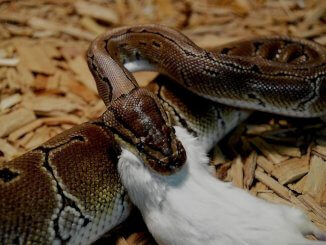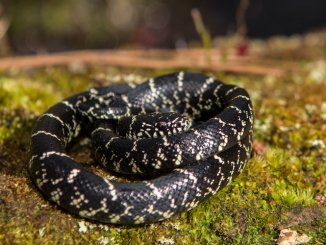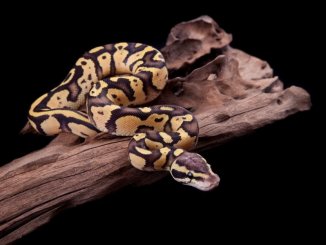The prairie kingsnake (Lampropeltis calligaster) is a non-venomous, moderate-sized tan snake with dark dorsal blotches. It is found primarily across the Southeastern United States.
Prairie kingsnakes spend most of their time in open grassy areas, forests, or woodlands. They live near bodies of water like creeks and lakes.
Captive-bred prairie kingsnakes are hardy and peaceful. They are easy to care for if the appropriate enclosure conditions are met.
Prairie Kingsnake Overview

| Category | Rating |
| Common Names: | Prairie kingsnake, yellow-bellied kingsnake |
| Scientific Name: | Lampropeltis calligaster |
| Natural Habitat: | Grassy open areas, wooded areas, near a water source |
| Adult Size: | 2 – 3.5 ft |
| Average Lifespan: | 15 years |
| Diet: | Carnivore |
| Housing: | Large vivarium, hiding spots, branches for climbing thermogradient, moderate humidity |
| Experience Level: | Beginner |
Origin
The prairie kingsnake (Lampropeltis calligaster) is native to North America. The snake is found in Southeastern and Midwestern areas of the United States, such as Texas, Florida, Nebraska, and Virginia. The International Union for Conservation of Nature (IUCN) doesn’t consider the species endangered. It is presumed their wild population is stable and exceeds over 100,000.
Prairie kingsnakes thrive in open, grassy areas near bodies of water like lakes, creeks, and rivers. They also do well in woodlands or sandy coastlines with abundant driftwood.
Prairies prefer dry and loose substrate and are seldom active on the surface. They spend most of their time in animal burrows. These snakes enter brumation over the winter.
The prairie kingsnakes’ genus name is Lampropeltis and derives from the Greek language. Lampropeltis means “shiny shield.” The name pays homage to the snake’s smooth and glossy scales.
Prairie kingsnakes are immune to certain venomous snake species, including cottonmouths and copperheads. They often prey on other snakes, a trait that gave them their common name, “kingsnake.”
Appearance and Behavior
Prairie kingsnakes are medium-sized snakes that have a tan or brownish-gray hue. Their dark dorsal blotches are their most distinct features. These blotches span across their entire body. These markings are round and are either gray, brown, or red. Each blotch has a narrow black border.
Prairie kingsnakes have smooth, glossy scales and U or V-styled markings on the top of their head. Their venter (belly) is a yellow-tan color with brown checkered markings.
These snakes have a dark stripe that spans from their eye to their jaw. They have a single anal plate.
Juvenile prairies are lighter than adults, and their patterning is more distinct. Older prairies can develop stripes that go down their back. Male prairie kingsnakes are bigger than females in size and length and have longer tails than females. There are color morphs available, with the most popular being the hypo albino prairie kingsnake.
Size and Lifespan
Captive prairie kingsnakes have an average lifespan of 15 years and grow up to 42 inches long. Average male adults have a snout to vent length of 34 inches and weigh 216 grams, while average adult females are 32 inches long and weigh 175 grams. These snakes can live up to 20 years in ideal conditions and with appropriate care.
Temperament
Prairie kingsnakes are docile and reclusive. They are seldom aggressive and don’t bite, but they can be territorial during breeding. Prairies become inquisitive once their confidence grows.
Prairie kingsnakes flatten themselves and exhibit white spots when they feel stressed or scared. They are well-tempered when handled, though it will take the snakes some time to get used to human contact.
These snakes are rarely surface-active. They spend around 75% of their time in burrows or underneath debris, leaf litter, and rocks. They are solitary and only engage with one another during breeding. They should be kept alone in a vivarium. Prairies are known to eat smaller snakes, and cannibalism does occur.
Prairie kingsnakes are part of the colubridae family. They exhibit common colubrid behaviors such as:
- Constricting prey
- Shaking their tail if they feel threatened or harassed
- Excreting musk to warn off predators
- Egg-laying
Housing Prairie Kingsnakes
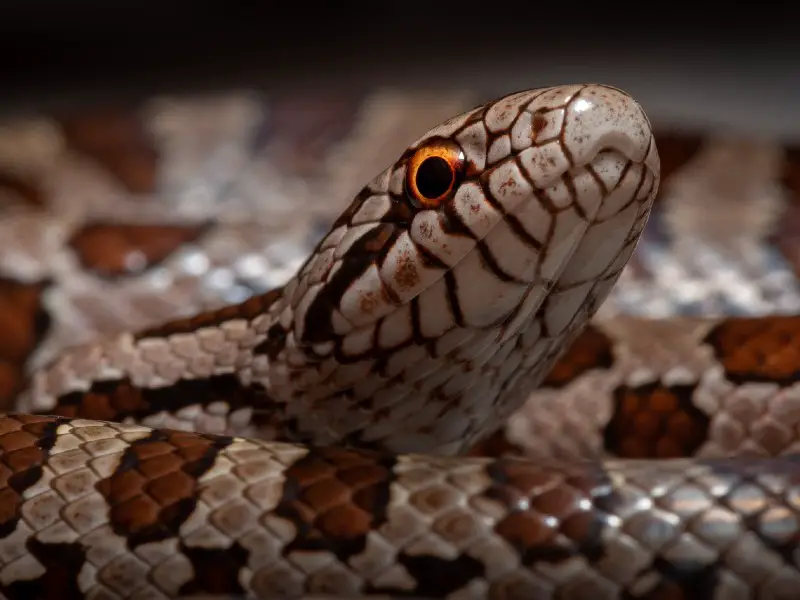
Prairie kingsnakes thrive in open areas near a permanent water source. They prefer loose, soft substrate and remain underground for most of their life.
Prairies will feel safe and secure in enclosures that replicate their natural habitat. Provide these snakes with a roomy vivarium containing plenty of hiding spaces. Tanks with fitted, secure lids are also appropriate. The substrate should be a few inches deep since these snakes enjoy burrowing.
Enclosure size
A prairie kingsnake requires an elongated vivarium that is at least 34 inches long. This will allow the snake to stretch out comfortably. The width of the enclosure should be at least a third of the prairie kingsnake’s length.
Make sure the vivarium has some vertical space. These sakes will climb, so the vivarium should be high enough to accommodate a climbing area. Young prairie kingsnakes can be housed in a 10 or 20-gallon tank and should move to a larger setup as they grow.
Lighting
Prairie kingsnakes will become stressed when exposed to constant lighting. Stick to lighting patterns that replicate a natural day to night cycle (eight to 12 hours of light per day, depending on the season).
Snake keepers will need to set up a photo gradient. Make a light area and a shaded area in the vivarium. Place the light source where the heat source is, so the cool area remains shaded.
Prairie kingsnakes spend most of their time underground. Low-intensity UV lighting is beneficial and will boost their immune system. Research is still ongoing on whether snakes benefit from UVB lighting.
Temperature and Humidity
The basking area should be between 84°F to 88°F, while the cool area should be between 70°F to 75°F. Switch off light sources in the evening to replicate day-to-night conditions. The enclosure’s temperature shouldn’t drop below 64°F when the light source is off. If necessary, incorporate a heat source that doesn’t give off light, like a heating pad with thermostat control.
Ensure light sources that give off heat are always guarded to prevent burns and other injuries.
Prairie kingsnakes are ectothermic. They use the external environment to regulate their body heat. Setting up a thermogradient in the vivarium, where there are both hot and cold zones, allows prairie kingsnakes to safely regulate their body heat.
Use digital thermometers to monitor temperature levels. Place a thermometer on each side of the vivarium. The thermometers should be positioned slightly above the substrate.
Prairie kingsnakes do best in humidity between 40% to 55%. Inappropriate humidity can cause respiratory problems and will hinder shedding. Measure humidity with a hygrometer. Increase ventilation if the humidity goes over 55% in the vivarium.
Lightly spray the vivarium every so often to ensure there is enough moisture. Spray more water when the snake is shedding. High humidity levels (55%) help with the shedding process. Set up a humid hide to provide the snake with a hiding spot that holds moisture.
Substrate and Decoration
The substrate must be dry and deep to allow for burrowing behavior. Aspen shavings and cypress mulch will best replicate prairie kingsnakes’ natural environment and won’t increase humidity.
Avoid cedar and redwood shavings as they contain toxic oil. You should also avoid harsh, grainy sand substrates that can irritate the snake’s skin.
Incorporate leaf litter to further help prairies feel at home. Ensure leaves have been sterilized and are completely dry before adding them to the vivarium.
Add plenty of hiding spaces to help prairie kingsnakes feel at ease. Create these hiding spots with rocks, plastic plants, driftwood, caves, and pots. Hiding places should be spacious for kingsnakes to fit their entire body inside but small enough that there isn’t excess room.
Spread hiding spots throughout the vivarium. Ensure there are plenty of hiding places in both the hot and cold zones.
Add sterilized, dry branches to the vivarium. These branches help prairie kingsnakes climb. Climbing helps prairie kingsnakes stay active and get rid of excess energy. Snakes also rest in branches and use them as a shedding aid.
Prairie kingsnakes are curious snakes that love exploring. Change the vivarium’s layout monthly to prevent boredom.
Cleaning
Cleaning the prairie kingsnake’s enclosure regularly is essential. A poorly maintained vivarium can lead to harmful bacteria growth and makes the snake prone to stress and health issues.
Give the enclosure a deep clean monthly:
- Remove the substrate and spray down decorations and the enclosure’s walls with a mild chlorine solution or reptile-friendly disinfectant spray.
- Thoroughly scrub away trapped debris or dirt.
- Rinse the disinfectant off with water.
- Replace the substrate and put the decorations back into the enclosure once they have fully dried.
Always clean waste immediately. Replace dirty substrate regularly, especially after soilage. If the snake excretes in its water bowl, disinfect the bowl and replace the water.
Wash your hands and wear gloves while cleaning. Washing hands before handling the snake prevents infection.
Prairie Kingsnake Care
Prairie kingsnakes are hardy and easy to care for. They will live their best life with a nutritious diet and a vivarium that mimics their natural habitat. The vivarium should contain hiding spots, a climbing area, and a suitable thermogradient. The substrate must be deep and soft.
Prairie kingsnakes are prone to respiratory infections. Keep appropriate humidity in the enclosure to prevent an infection. Adult prairie kingsnakes should eat once every two weeks. Feed them thawed mice. Replace their water daily.
Food and Water
The prairie kingsnake is carnivorous. The snake eats rodents, frogs, birds, lizards, snakes, among other vertebrates in the wild. A captive snake consumes a diet of thawed mice. Mice should be around the size of the snake’s girth or slightly larger.
Adult prairie kingsnakes must eat an adult mouse once every 10 to 14 days. Hatchlings should eat every five to six days. Hatchlings should begin with pinky mice and gradually move on to hopper mice. Avoid live mice, as they can scratch and injure prairie kingsnakes.
Set up a large water bowl at the cool end of the vivarium. The bowl must be tip-proof and deep. The prairie kingsnake should be able to submerge itself in the water. Replace the water regularly to maintain cleanliness.
Handling
Prairie kingsnakes are docile and easy to handle. However, young snakes take a while to adjust to handling. Handle these snakes for five minutes at first and return them to the vivarium. Increase their handling time by five minutes every time.
Scoop up the prairie kingsnake gently, and don’t handle it more than once a day. Overhandling can cause stress. Handling the snake while it sheds its skin is also forbidden. This is because the prairie kingsnake becomes agitated when it sheds. Opaque eyes and dull skin indicate the snake is shedding.
Avoid handling the prairie if it has just eaten. Wait 48 hours before handling the snake. Otherwise, it can regurgitate its food. Always wash your hands before and after handling.
Common Health Issues
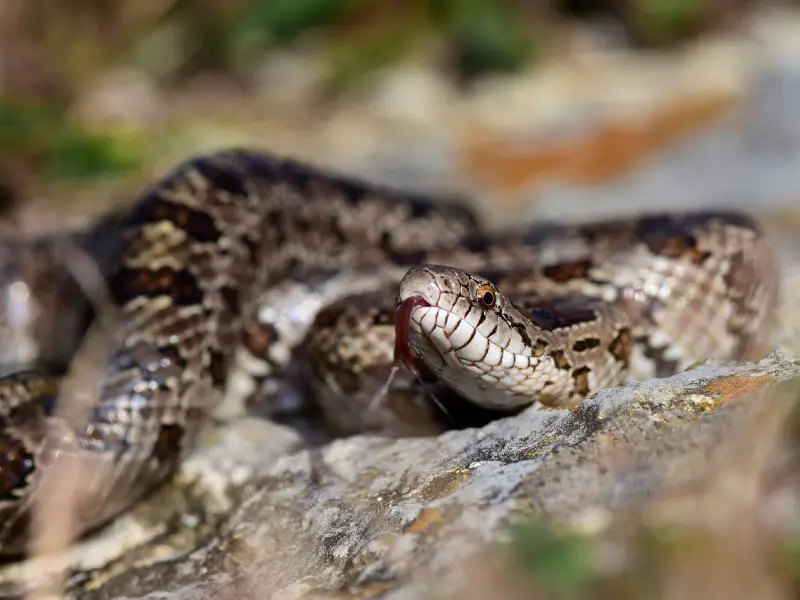
Prairie kingsnakes are a hardy species, but common health issues include mites, respiratory infections, and regurgitation.
Respiratory Infections — Respiratory infections can occur from poor enclosure conditions, especially inappropriate humidity levels. Signs of a respiratory infection include nasal discharge, excessive saliva, and wheezing. Keep the enclosure clean and at the right humidity level to prevent respiratory infections. Severe infections require medical care.
Mites — Mites are tiny parasites that feed on snake blood. Mites primarily live under scales and around the mouth and eyes. A prairie kingsnake with mites can become lethargic and will lose its appetite. Wash the snake in warm water and disinfect the enclosure to treat mites.
Remove the substrate and replace it with tissue. Keep decorations minimal until mites are gone. Repeat the bathing and disinfecting process several times if needed. Buy the appropriate treatment from a veterinarian or a reptile shop.
Regurgitation — Regurgitation can cause stress and even death in prairie kingsnakes. Avoid handling snakes soon after feeding to prevent regurgitation. You should also make sure their meals are the appropriate size. If regurgitation continues, get medical help immediately.
Breeding
Mating will occur when males and females share an enclosure during the breeding season. Ensuring both snakes are healthy and the enclosure conditions are optimal to encourage breeding. You should also ensure the prairie kingsnakes have undergone brumation. Prairie kingsnakes naturally breed after brumation in the wild.
Prairie kingsnakes produce five to 17 offspring each time. Females shed their skin before breeding, which indicates their readiness to breed. Follow the steps below to breed a pair of prairie kingsnakes:
- Put the desired pair together. Receptive behavior includes the male following and “pinning” the female. The female will thrash her tail and try to escape if she isn’t ready to breed.
- Remove the pair immediately if one of the snakes shows signs of disinterest.
- Snakes that show readiness to breed will begin to lock together. This is called copulation.
- The locking pair should stay in the enclosure until the process has finished. Copulation can take a few hours.
- Separate the pair when the mating ritual finishes.
Supervise males and females as much as possible when they are together. Prairie kingsnakes are known for their cannibalistic tendencies. Females would undergo a second shedding after four to eight weeks if mating was successful.
A gravid female prairie will need a box to safely lay her eggs. The box must be spacious enough for the female to move about in it properly. Keep the box moist with a layer of damp sphagnum moss. It can take up to two weeks for a female to lay her eggs. Check the nesting box daily and remove eggs immediately.
Don’t attempt to separate or turn the eggs. Otherwise, you could damage the shell or cause the embryo to detach from the shell wall. Feed the female once she has finished laying her eggs. You should perform a physical examination to ensure she hasn’t got any more eggs to lay.
Keep eggs incubated at 80°F to 82°F. Eggs will hatch within 50 to 70 days. The enclosure must have a high humidity level. Boost humidity levels with a damp, high moisture substrate like Thatcherite or vermiculite.
Separate hatchlings and put them in separate enclosures. Hatchlings will try to eat each other if they are kept together.
Choosing and Buying a Prairie Kingsnake
Prairie kingsnakes are easy to care for and have docile temperaments. They are popular among experienced and beginner herp keepers. Hobbyists shouldn’t take prairies from the wild as there are lots of captive-bred snakes on the market.
These snakes cost between $80 to $200 per snake. Prices depend on age, location, color morph, and more. Hypo albino prairie snakes will cost more than regular prairie kingsnakes. Most reptile specialty stores stock prairie snakes. Hobbyists must look for reputable breeders.
Healthy prairie kingsnakes will flick their tongue regularly, have bright eyes, and smooth, non-blistering skin. They will eat willingly and won’t exhibit breathing difficulties.

